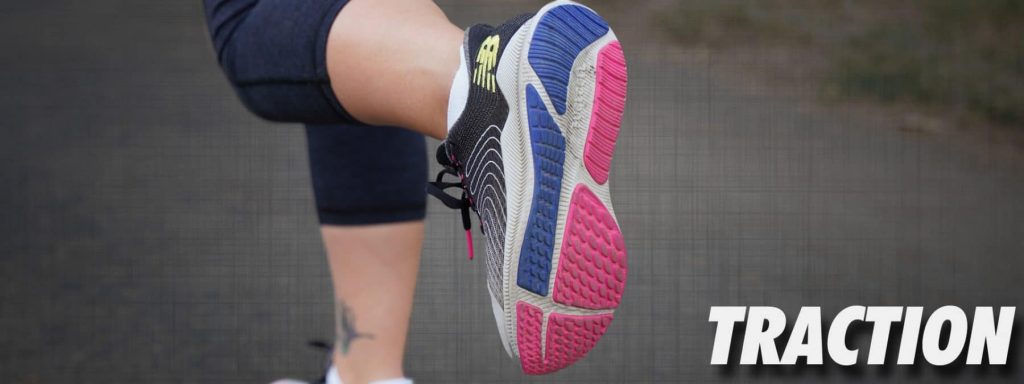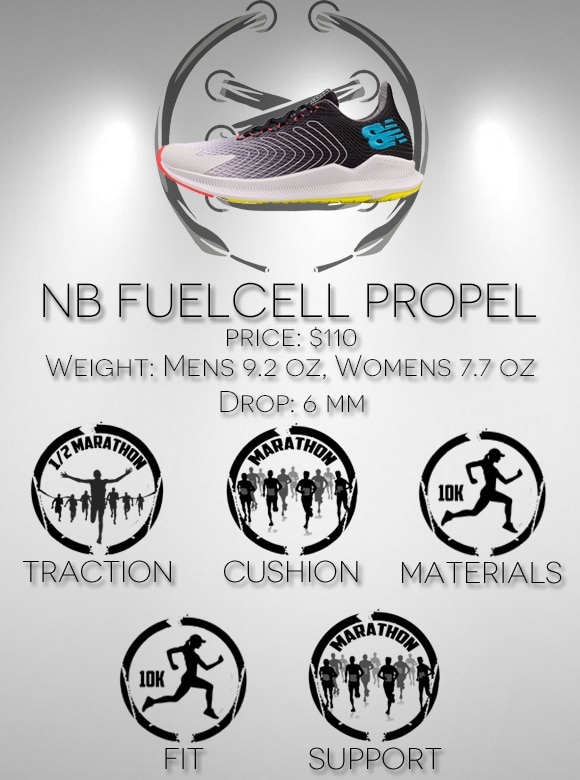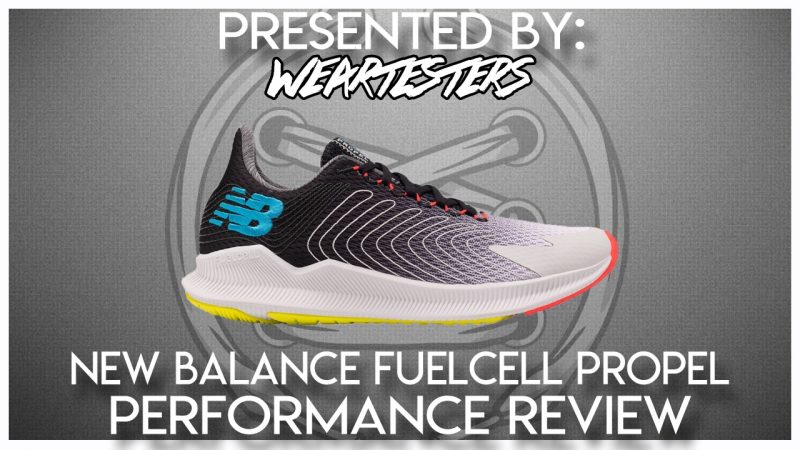The New Balance FuelCell Propel is the first neutral cushioned every day runner using New Balance’s FuelCell cushioning technology. FuelCell was previously featured on the shoe Kawhi Leonard was wearing during the NBA playoffs, the New Balance OMN1s. Previous iterations of FuelCell, including the OMNI1s, had a reputation as a bouncy but very firm cushioning system. So has New Balance tweaked the formula?
FuelCell is a nitrogen-injected TPU foam. The nitrogen part is what makes it unique versus Adidas’ Boost or Saucony’s Everun. Normal air is 78% nitrogen which means it’s not a huge departure from using air. New Balance’s scientific explanation is that nitrogen doesn’t expand/contract as much as air. It’s similar to the air in your tires and why using nitrogen to fill car tires is now a thing. So how does FuelCell work when running multiple miles on varied terrain? Let’s find out.

Jodi: Snappy is the word we were throwing around in Chris and I’s detailed look video a few weeks ago. Once I laced up the New Balance FuelCell Propel, I always felt like I had an extra spring in my step. And it was a feeling I had from mile 1 all the way through mile 9. You can’t say that about all cushioning systems. I love a good bouncy cushioning setup, especially when it’s ample and equally tuned from heel to toe like the FuelCell used in the Propel.
Drew: As Jodi mentioned, FuelCell has great bounce and energy return. I noticed that propulsive feeling you get with the bounciest cushioning setups. FuelCell also provided a nice responsive ground feel. It doesn’t feel high off the ground even though there’s ample cushion. Initially, I questioned if it was enough cushioning for long runs. But when I did a few 10+ mile runs in them the cushion didn’t ever bottom out or feel flat. And the FuelCell in these packs a great bounce for 200s, 400s, or other speed work on the track. This nice implementation of FuelCell has me looking at buying other models utilizing the tech (like the Tekela and Rebel).

Jodi: I spend most of my runs in your typical suburban neighborhood. The rubber outsole was not only flexible but durable. The lugs are spaced out enough to allow rocks and other rogue tree debris to shake free when I’d run across them. And the rubber looks like it’s going to last quite some time. After 50+ miles, I’ve lost some texture but all of the lugs are still accounted for.
Drew: My traction is wearing away faster than Jodi’s over the same amount of miles. I’ve almost lost the 3 lugs closest to the forefoot flex point. That may partially have to do with where I land. Overall, it’s not a ton of wear and I’d expect to get the typical 300 miles out of this shoe. The traction itself worked great in all conditions. Trails, gravel, and driving rainstorms didn’t cause any issues.

Jodi: I felt like the New Balance FuelCell Propel has support covered. The heel is very structured but padded. It swoops away from your achilles so there’s no weird pressure points (for me). The midsole wraps up around your foot a bit so you’re tucked in nicely. There is a nice little swooping design stitched into the upper along both sides. At first I thought it was just for looks, but the design also served the purpose of giving the upper a bit more shape and structure.
Drew: I did have a couple pressure points on the collar of the shoe but I’ll touch on that during the fit section. I felt the support was awesome for a neutral runner. Jodi’s right about sitting inside the midsole. It really helps lock your heel in place even with the laces tied fairly loose. The other part of the support I thought really helped was the wide base. The base flares out on both sides of the forefoot and heel so you end up with four large outriggers. It’s something I’ve never considered including on a running shoe but it made a noticeable difference in a bunch of circumstances. If you’re the type of runner who needs support but doesn’t need an actual support shoe, try out the FuelCell Propel.

Jodi: The Propel has a very traditional build as far as running shoes go. It did get a more modern touch with the collar arching away from your achilles. Good old-fashioned open celled mesh is the primary body material. It’s not fancy but it gets the job done. It’s worth noting that the tongue is semi-attached. This particular feature didn’t bother me at all and you can’t tell that they were trying for a bootie upper at first glance. But it is something to look out for if you’re one of those runners who despises attached tongues.
One of my favorite parts about the shoe is the laces. They’re flat and have the perfect amount of stretch. I was able to tie them once, NOT double knot them, and never give them another thought. That almost never happens and it’s sincerely appreciated.
Drew: I have to give those stretchy laces some love too. They’re just always a welcome addition to any running shoe and New Balance as a brand is as devoted to them as I am. Jodi already covered the mesh body (nicely breathable) and semi-attached tongue (didn’t notice it all) so I’ll focus on the back third of the shoe. The ankle area is made of a sort of t-shirt material. It’s not cotton, more like a tech fit t-shirt. It does retain moisture and get stinky in humid climates. The stinkiness went away with one cycle in the washing machine but I know that sort of thing can be a pet peeve for some runners.

Jodi: This is a runner that I felt was made for my specific foot type. I didn’t have a single blister or inkling of a hotspot arise on any of my piggies. I never had a run where I felt like my feet were being suffocated. I didn’t have to think about what socks I was going to wear due to space issues. And trust me, that is not something I can say about most runners given my wide feet. For me in particular, the fit category can be a struggle for my foot type. So for all the wide footers out there, New Balance has taken care of us with the FuelCell Propel.
Drew: So we’re just casually calling toes “piggies” in reviews now? SMH. I can’t support this. Sigh. Back to our regularly scheduled programming…
I have a narrow foot and had plenty of room for foot splay. The FuelCell Propel didn’t feel too wide or like there was too much space. It’s often hard for brands to please both wide and narrow footers but New Balance achieved that balance here.
The only Fit problem I had was with the collar area. There were two small hotspots on the left side of each collar. Which is weird because the lack of symmetry is unusual for shoes. There are two small knots of thread on the left side of each shoe. They’re located right at the top of the collar underneath the tech fit type material. On my right foot, this didn’t bug me at all. On my left foot, I got two blisters. One on the underside of my ankle and the other along the backside of my ankle. Whether these hotspots affect you is wholly dependent on your ankle shape. My ankle sits low and that’s why they hurt me. Luckily, they’re not huge hot spots and wearing socks that covered my ankle solved the problem.

Jodi: I’ve spent the last couple weeks basically gushing about the New Balance FuelCell Propel to anyone and everyone who has asked about what kind of runner they should pick up. At $110, it doesn’t break the bank and you’re getting your money’s worth. This shoe is definitely staying in my current running rotation.
Drew: This shoe is a great value at $110. It’s super versatile and will likely become a key part of your rotation if you buy it. Check and make sure you don’t have the same hotspot issue as me because if you don’t, you’re about to get a really awesome cushioning setup and a traditional upper that will tackle whatever training you have planned each day.

Thanks to New Balance for sending us pairs to test. New Balance was not given any editorial control of the review. This review is based on our weartesters’ experiences using the shoes for speed workouts, trail runs, treadmill training, long runs, casual wear, and more.




